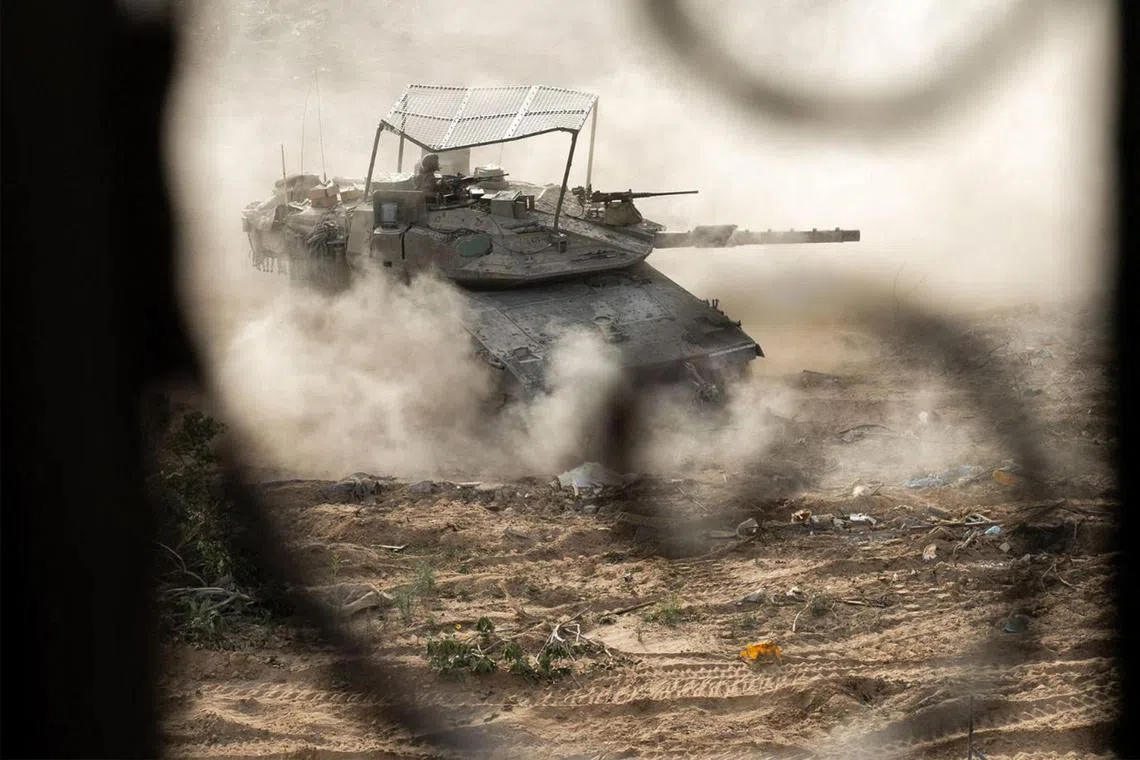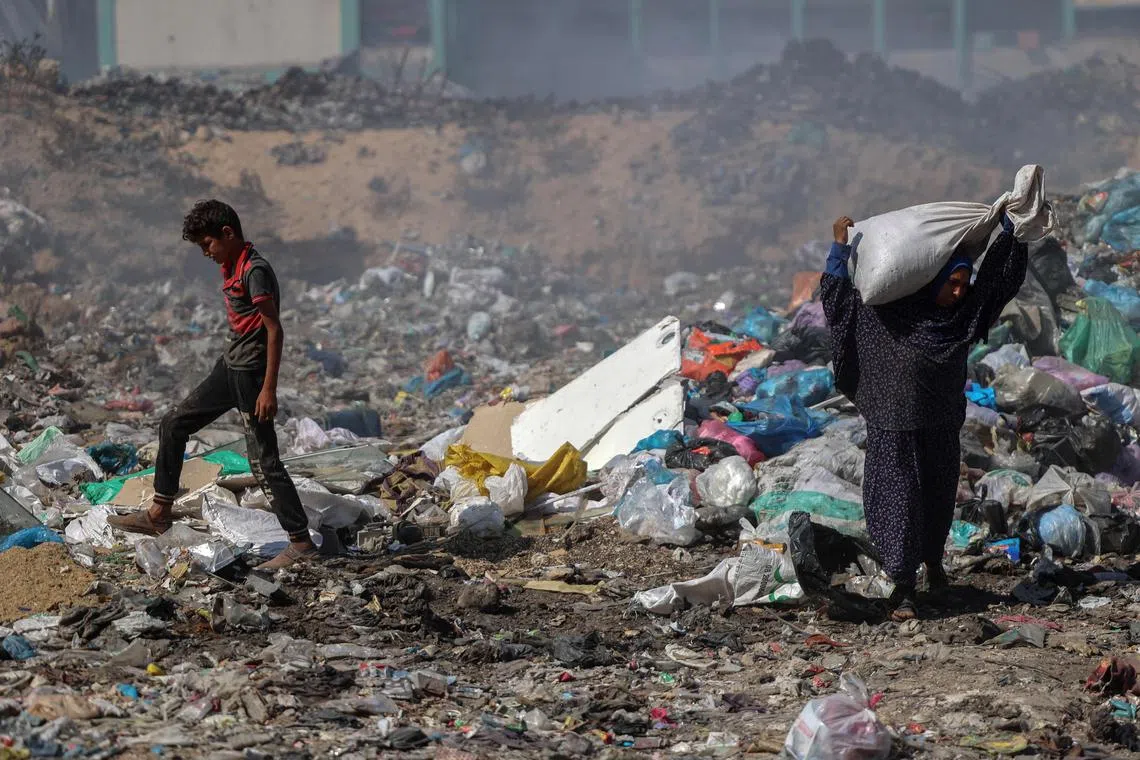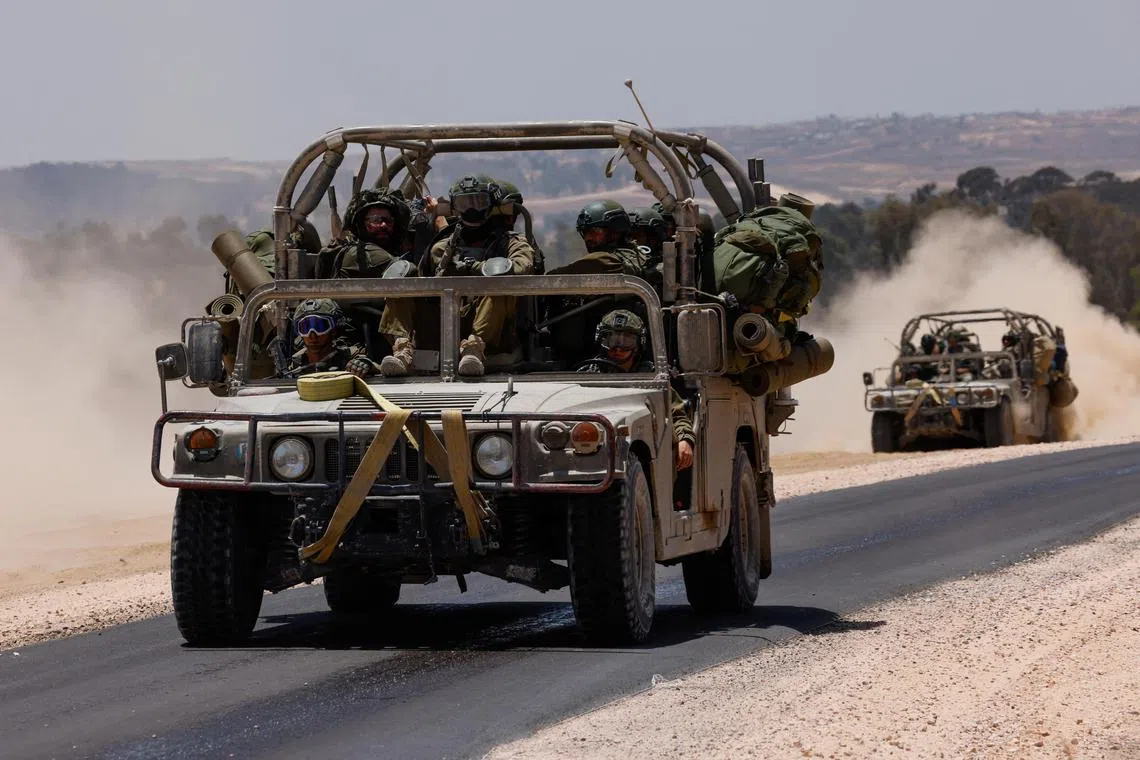News analysis
4 scenarios for next phase of war in Gaza Strip, with ‘intense’ fighting set to end
Sign up now: Get ST's newsletters delivered to your inbox

Israeli Prime Minister Benjamin Netanyahu has made it clear that a ceasefire in Gaza is not at hand, and the next fight might be in Lebanon with Hezbollah.
PHOTO: AFP
Follow topic:
JERUSALEM – Israel’s prime minister says the war in the Gaza Strip will soon enter a new phase.
“The intense stage of the war with Hamas is about to end,” Prime Minister Benjamin Netanyahu said in a television interview on June 23. “This does not mean that the war is about to end, but the war in its intense phase is about to end.”
But whatever relief those comments may bring after more than half a year of horrific bloodshed, Mr Netanyahu quickly made two things clear: A ceasefire in Gaza is not at hand, and the next fight might be in Lebanon
Mr Netanyahu stopped well short of announcing an invasion of Lebanon, a move that would likely result in heavy Israeli and Lebanese losses, and instead left open the door for a diplomatic resolution with Hezbollah.
Any diplomatic resolution in Gaza remains uncertain, in part because Mr Netanyahu’s coalition would likely collapse if Israel stopped fighting in Gaza without having removed Hamas from power.
Still, the Prime Minister appeared to be signalling that Israel, after finishing its current military operation in Rafah, Gaza’s southernmost city, would not seek to mount major ground invasions of cities in central Gaza, the only area of the territory where the Israeli military has not carried out such attacks.
While Israeli leaders have said since January that they were transitioning to a lower-intensity war, the end of the Rafah operation might allow for the completion of that process.
The remarks from Mr Netanyahu, and recent comments by Defence Minister Yoav Gallant, who was in Washington on June 24, indicated that the focus of Israel’s political discourse and strategic planning is shifting to its northern border with Lebanon.

Palestinians searching for salvageable items in a rubbish dump, which sprawls across what used to be the Firas market in Gaza City, on June 24, 2024.
PHOTO: AFP
In a June 24 statement, Mr Gallant’s office said that he had discussed with US officials “the transition to ‘Phase C’ in Gaza and its impact on the region, including vis-a-vis Lebanon and other areas”.
Early in the war, Mr Gallant outlined a three-phase battle plan that included intense air strikes against Hamas targets and infrastructure; a period of ground operations aimed at “eliminating pockets of resistance”; and a third phase, or Phase C, that would create “a new security reality for the citizens of Israel”.
Since October, Israel has been fighting a low-level conflict with Hezbollah that has displaced hundreds of thousands of civilians on both sides of the border. But the fighting has been overshadowed by the larger war in Gaza.
The shift in rhetoric over the weekend could be the harbinger of a major escalation between Hezbollah and Israel.
Israeli officials have been warning for months that they may invade Lebanon if Hezbollah, a powerful Iranian-backed militia that dominates southern Lebanon, does not withdraw its forces from near its border. Hezbollah has also threatened to invade Israel.
But a diminution in the fighting in Gaza could also end up creating space for a de-escalation of the hostilities at the Lebanese border. Hezbollah joined the fight in October in solidarity with Hamas, and its leadership has indicated that it could wind down its campaign if the war in Gaza ebbs.
Here are four ways the shift in Israel’s stance in Gaza may play out.
1. Raids in Gaza, but smaller ones
Once the Israeli campaign in Rafah ends in the coming weeks, the military is expected to focus on hostage rescue operations across the Gaza Strip, like the one that rescued four Israelis early in June and killed scores of Palestinians.
Military officials also say they will continue to briefly raid neighbourhoods they captured during earlier phases of the war, to prevent Hamas fighters from regaining too much strength in those areas.
Templates for that kind of operation include Israel’s return to Shifa Hospital in Gaza City in March, four months after first raiding it, or its three-week operation in May in Jabalia, which Israeli forces first captured in November.

A Palestinian child walking with a stuffed bear recovered from the rubble of a destroyed building in Khan Yunis on June 21, 2024.
PHOTO: AFP
2. Gaza power vacuum
By withdrawing from much of Gaza without ceding power to an alternative Palestinian leadership, Israel might essentially allow Hamas’ leaders to retain their dominance over the ruined enclave, at least for now.
It is possible that if it raided Gaza regularly, the Israeli military could prevent Hamas from returning to its former strength – but that would prolong a power vacuum in which large clans and gangs compete with Hamas for influence. That vacuum would make it even harder to rebuild Gaza, distribute aid and alleviate civilian suffering.
Israel is expected to retain control of Gaza’s border with Egypt to deter arms smuggling there. It is also expected to continue to occupy a strip of land that separates northern and southern Gaza, preventing free movement between the two areas.
3. War with Hezbollah, or calming
By moving more troops to its northern border, Israel’s military would be better placed to invade Lebanon so it could force Hezbollah’s fighters farther from Israeli territory.
But a build-up of troops there could provoke more rocket strikes from Hezbollah, increasing the likelihood of a miscalculation that could spiral into all-out war. Hezbollah leader Hassan Nasrallah warned last week that the group could invade Israel, and the risk of escalation appears closer than it has in months.
At the same time, Israel’s declaration that it is moving into a new phase in Gaza could also provide a context for de-escalation. Less fighting in Gaza could give Hezbollah an off-ramp. In February, Mr Nasrallah said that his group would stop firing “when the shooting stops in Gaza”.
A period of relative calm along the Lebanon border might also prompt displaced Israelis to return home. That, in turn, would ease pressure on the Israeli government to take firmer action against Hezbollah. One of the main reasons Israeli leaders considered invading Lebanon was to create conditions in which displaced Israelis could be convinced to return home.

Military vehicles near the Israel-Gaza border on June 20, 2024.
PHOTO: REUTERS
4. Continued tensions with Biden administration
By announcing a drawdown in Gaza, Mr Netanyahu reduced one source of friction with US President Joe Biden, but maintained others.
Mr Biden has criticised Israel’s conduct of the war,
But Mr Netanyahu’s refusal to articulate a clear plan for post-war governance of Gaza, as well as the lingering possibility of an Israeli invasion of Lebanon, leaves ample opportunity for disagreement with Washington.
The Biden administration wants the fighting with Hezbollah to end, and it has pressed Mr Netanyahu for months to empower an alternative Palestinian leadership in Gaza. But Mr Netanyahu has kept Gaza’s future vague, amid pressure from his right-wing coalition partners to occupy and resettle the territory with Israelis. NYTIMES

